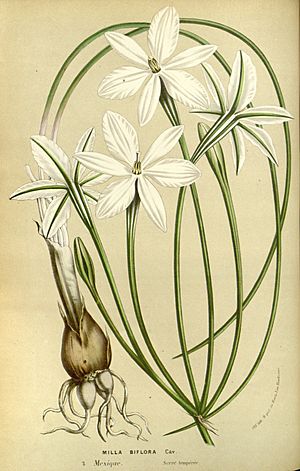Mexican star facts for kids
Quick facts for kids Mexican star |
|
|---|---|
 |
|
| 1861 illustration | |
| Scientific classification | |
| Synonyms | |
|
Milla biflora, often called the Mexican star, is a beautiful flowering plant. It is native to parts of North America and Central America. You can find it growing naturally in places like Arizona, New Mexico, and Texas in the United States. It also grows in Mexico, Honduras, and Guatemala.
The Mexican star plant likes to grow in high places. It is often found at elevations between 1,000 and 2,700 meters (about 3,300 to 8,900 feet) above sea level. This plant is a perennial, which means it lives for more than two years. It comes back to life year after year from an underground storage part.
About the Mexican Star Plant
The Mexican star grows from a small, round underground part called a corm. This corm is like a small, solid bulb, usually 1 to 2 centimeters (less than an inch) wide. It helps the plant store food and water.
What It Looks Like
In the summer, the Mexican star plant shows off its pretty white flowers. These flowers grow on a special stalk called a scape. A scape is a long, leafless stem that comes directly from the ground. These scapes can be quite tall, from 4 to 55 centimeters (about 1.5 to 21 inches) long.
Each plant can have one to nine white flowers on its scape. The leaves of the Mexican star are long and thin, like blades of grass. They are about 1 millimeter wide and can be half as long or even as long as the flower stalk.
Life Cycle
After the flowers bloom, the plant produces fruits. These fruits are shaped like an egg and are called capsules. They are about 1.5 to 2 centimeters (about 0.6 to 0.8 inches) long. Inside these capsules are the seeds, which will grow into new Mexican star plants.

